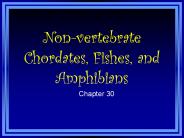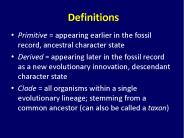Cephalochordate PowerPoint PPT Presentations
All Time
Recommended
Non-vertebrate Chordates, Fishes, and Amphibians Chapter 30 Phylum Chordata Contains three sub-phyla: Vertebrata Urochordata Cephalochordata All chordates at some ...
| free to download
None gastrovascular cavity complete digestive system. Body cavities ... Larval urochordate exhibiting paedogenesis* cephalochordate * Early sexual maturity. ...
| free to download
Biology 340 Comparative Embryology Lecture 6 Dr. Stuart Sumida Introduction to Embryology of Chordata Cephalochordata Amphioxus ...
| free to download
Vertebrate Evolution and Diversity Phylum Chordata Subphylum Urochordates Subphylum Cephalochordates Subphylum Vertebrates Lancet Tunicate
| free to view
(1) Bottom-dwelling filter feeder with lophophore arms (2) ... (Cephalochordate) (Urochordate) (Enteropneusts) Possible evolutionary tree of early vertebrates ...
| free to view
B.J. Swalla, Univ. of Washington, http://faculty.washington.edu/bjswalla/ Urochordates ... link, WU-STL Tip Sheet, http://news-info.wustl.edu/tips/2002/science ...
| free to view
Marine Vertebrates: Lecture 1 Form and Function: Fish (begin)
| free to download
Chapter 34 The Origin and Evolution of Vertebrates
| free to view
Crinoidea (sea lilies) Asteroidea (starfishes) Ophiuroidea (brittle stars) Echinoidea (sea urchins) Holothuroidea (sea cucumbers) ...
| free to download
See figure 3-6. Lamprey- Vertebrate Ectoparasites ... Weeland canal around Niagra falls ! Lamprey Control: Exploiting basic natural history ...
| free to download
Protochordates include Urochordates = Tunicates = Sea squirts (See figure 2-2 in text) Underappreciated beauty of tunicates Notochord Dorsal hollow nerve cord Pharynx ...
| free to download
Classification General Features. Basic Unit of Classification = Species. Biological Species Concept = a group of similar-looking individuals capable of ...
| free to download
... dolphins and whales Humpback Whale Bottlenose Dolphin Marine Mammals There are 3 ... sea otters and polar bears Beluga Whale * Class Chondrichthyes ...
| free to view
Trends in Animal Evolution Symmetry ... deuterostome Digestive system None gastrovascular cavity complete digestive system Body cavities acoelomate pseudocoelomate ...
| free to download
One of these types of animals gave rise to vertebrates, ... Gnathostomata is subdivided into Pisces with fins and Tetrapoda, usually with two pair of limbs. ...
| free to view
Introduction to Chordates ... Chordates
| free to view
Phylum Cnidaria General Characteristics They are radially symmetrical; ... Ancylostoma ( Hook worm) Annilida : Annullus: little ring Triploblastic, ...
| free to download
presented and prepared by sadia khurshid lecturer zoology department da college for women,phase viii phylum chordata (protochordates ...
| free to download
2) different individuals have different features, and. some of those features are ... (an isopod crustacean) courtesy of The Paleo Project ('House of Phacops' ...
| free to view
Chapter 25: Vertebrate Diversity
| free to download
Chapter 25: Vertebrate Diversity Three Groups of Amphibians Caecilians Are legless, burrowing amphibians that live in the tropics. There are 160 species ranging in ...
| free to download
Class Osteichthyes: bony fish (salmon, trout) ... bald eagle) Swimming bird (such as a duck) Subphylum Vertebrata. Class Mammalia ...
| free to view
Endoskeleton An internal skeleton built of bone or cartilage Vertebrate Classes Agnatha Chondrichthyes Osteichthyes Amphibia Reptilia Aves Mammalia Class Agnatha ...
| free to view
The Behavior of White Sharks and their Pinniped Prey during predatory attacks ... Focus: reef sharks (requim) Order Orectolobiformes Carpetsharks: Overview ...
| free to view
* Class Amphibia Class Reptilia Class Aves Class Mammalia Oldest class of tetrapods 4000 extant species of frogs, ...
| free to view
Define the major branches of the phylogeny by the evolution of the following traits: ... (class Chondrichthyes): Great white shark (top left), silky shark (top right) ...
| free to view
Radial, indeterminate cleavage exhibited by early embryo. Coelom forms by enterocoely ... Superficial radial body form (which is secondarily derived from ...
| free to view
Title: PowerPoint Presentation Author: GES GES Last modified by: Coast Tsimshian Academy Created Date: 11/5/2002 12:14:22 AM Document presentation format
| free to download
Now Three Domains and 6 Kingdoms. Conventional Classification of ... Hydra. sea pens. soft corals. 2 tissue layers: ectoderm, endoderm. sea anemones. jellyfish ...
| free to download
Vertebrae Evolution & Diversity
| free to view
2 tissue layers: ectoderm, endoderm. sea anemones. jellyfish 'Worms' - 3 tissue layers. ectoderm, mesoderm, endoderm. Phylum Brachiopoda ('arm foot' ...
| free to download
Vertebrate Biology Lecture Notes The Phylum Chordata Vertebrates belong to the Phylum Chordata - these are animals that, at one stage or another of their life ...
| free to view
Read chapter 2 of the text Phylum Chordata The chordates are a group of particular interest to us as we belong to it, being members of the subphylum Vertebrata.
| free to view
Evolution of the Animal Body Plan Part 2 Chordates and Vertebrates E. Q. How has the chordate body plan evolved over time to better suit these animals to their
| free to view
Class Amphibia - amphibians - salamanders, frogs, caecilians (legless animals that burrow) ... Most amphibians rely heavily on moist skin to carry out gas ...
| free to download
Chordates Chapter 23 * * * * * * * * * * * * * * * * * * The Origin of Vertebrates Vertebrates evolved at least 530 million years ago, during the Cambrian explosion.
| free to download
... stage or another of their life cycle possess the following three characteristics: ... Pisces. Superclass. Tetrapoda. Anamniotes. Amniotes ...
| free to view
1) more individuals are born than survive Coral Genomics Group, Queensland, Australia 2) different individuals have different features, and some of those features are ...
| free to download
Stomodeum invaginates from ectoderm of body covering (breaks through) ... thecodont - fossil birds, crocs and gators, and mammals and imbedded in socket ...
| free to view
Mutation, that causes transformation of an ... The homeobox encodes a 60 AA length homeodomain = a DNA-binding helix turn helix ... This pattern is the zootype. ...
| free to view
(most obvious in: sea urchins, amphibians, ascidians) ... Amphibian development: Xenopus laevis. Animal hemisphere (pigmented in some species) ...
| free to view
... Gastropods 31 Alciopid Polychaetes 37 Sapphirinid Copepods 55 Corycaeid Copepods 80 Strombid Gastropods 105 Cypridinid Ostracods 140 Pontellid Copepods 216 ...
| free to download
... notochord, caudal fin rays, and what appeared to be a postanal tail and a dorsal ... hypocercal tail (with an extended ventral lobe) which suggest a trend towards ...
| free to view
1) Otx Arthropods/Chordates: Anterior CNS. Otx Urchin: Radial nerves ... Generally conserved in arthropods and chordates (A/P axis) ...
| free to view
Arthropods: Animals with Jointed Appendages Phylum Arthropoda = 75% of species Have exoskeleton a hard, protective exterior skeleton composed of protein and chitin ...
| free to view
Review for Lab Practical II
| free to view
Notochord extending from head region into tail (no vertebral column) ... Small tail fin with fin rays. Large eyes. Small size only about 40 mm long ...
| free to view
Amphibians are able to hibernate in cold or temperate regions, they also can go ... Food and eating-Most amphibians use their long flexible tongues to capture their ...
| free to view
| free to view
Cambrian to Early Carboniferous. Dominant planktonic animal in Paleozoic ... Cambrian to Early Carboniferous, but never a major part of fauna. Planktonic larvae ...
| free to view
vectors and rates of plate movement
| free to view
Important developments of the Vertebrates: brain and sense organs The ancestors of vertebrates switched from filter feeding to more active feeding, which required ...
| free to view
Name the three classes of fish. What are Classes Agnatha, ... Tell me three well developed senses a shark has. ... What is a salamander, a frog and a toad? ...
| free to view
... abundant food source: plankton and suspended organic matter ... no jaws - restricted to plankton, suspended organics - slow growth. Fate of Ostracoderms ...
| free to view
Phylum Chordata The chordates are a group of particular interest to us as we belong to it, being members of the subphylum Vertebrata. The chordates include all of the ...
| free to view
























































